Swim, Splash, and Play: Enjoy Life with Curly-Coated Retrievers!
Introduction and Breed Background
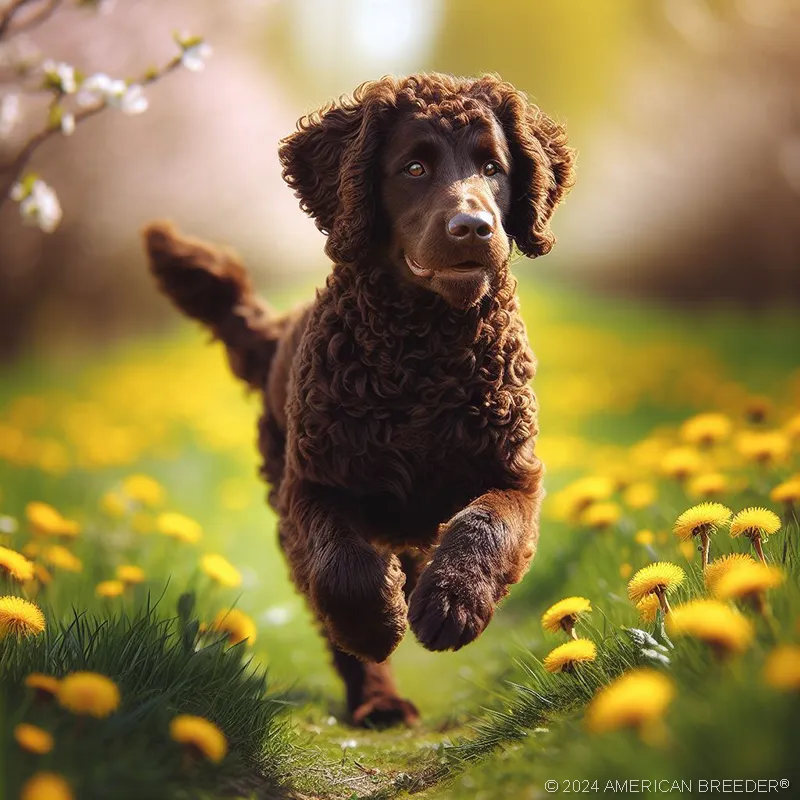 Welcome to the captivating world of the Curly-Coated Retriever Dog! In this comprehensive guide, we will delve into the unique characteristics, history, temperament, and various aspects of this incredible canine companion. Whether you are a seasoned dog lover or considering adding a Curly-Coated Retriever to your family, this guide aims to provide you with a wealth of information to deepen your understanding and appreciation for this remarkable breed.
Welcome to the captivating world of the Curly-Coated Retriever Dog! In this comprehensive guide, we will delve into the unique characteristics, history, temperament, and various aspects of this incredible canine companion. Whether you are a seasoned dog lover or considering adding a Curly-Coated Retriever to your family, this guide aims to provide you with a wealth of information to deepen your understanding and appreciation for this remarkable breed.
Brief Summary Description of the Curly-Coated Retriever Dog
The Curly-Coated Retriever, often fondly called the "Curly," is a remarkable and distinctive breed known for its striking appearance and exuberant personality. This medium to large-sized dog features a dense, curly coat that repels water, making it an outstanding retriever of waterfowl. Its unique curly coat sets it apart from other retriever breeds and adds to its charm.
With origins dating back to England, the Curly-Coated Retriever has a rich history as one of the oldest retriever breeds. It was initially bred for waterfowl retrieval, making it a skilled and versatile working dog. Today, it continues to excel in various roles, including hunting, dog sports, and family companionship.
Considerations Before Choosing the Curly-Coated Retriever Dog
Before bringing a Curly-Coated Retriever into your home, there are essential considerations to keep in mind. This breed requires an active lifestyle and plenty of mental stimulation. If you're an outdoor enthusiast seeking a loyal and playful companion for outdoor adventures, the Curly might be the perfect match.
Keep in mind that this breed has specific grooming needs due to its curly coat. Regular brushing and maintenance are necessary to keep the coat healthy and tangle-free. Additionally, early socialization and consistent training are vital to ensure a well-rounded and well-behaved companion.
Interesting Facts and Fun Facts about the Curly-Coated Retriever Dog
Nicknames for the Curly-Coated Retriever Dog Enthusiastic Curly-Coated Retriever owners often come up with charming nicknames for their beloved pets. From "Curly" and "Curls" to "Water Dog" and "Water Wizard," these affectionate monikers highlight the breed's unique qualities and lovable personality. In some regions, the Curly-Coated Retriever is also known by alternative names like "Curly Retriever" or simply "Curly." However, regardless of the name, its playful spirit and water-loving nature remain constant.
Breed Background and History
Origin and Development of the Curly-Coated Retriever Dog
The Curly-Coated Retriever's history traces back to 18th-century England, where it was bred to excel in waterfowl hunting and retrieving. Its ancestors likely include the now-extinct English Water Spaniel, the Irish Water Spaniel, and the St. John's Newfoundland. This blend of breeds contributed to the Curly's distinctive curly coat and water-resistant abilities.
As the breed gained popularity, it was recognized by the Kennel Club in England in 1854, solidifying its position as a sought-after retriever in both the United Kingdom and other parts of the world.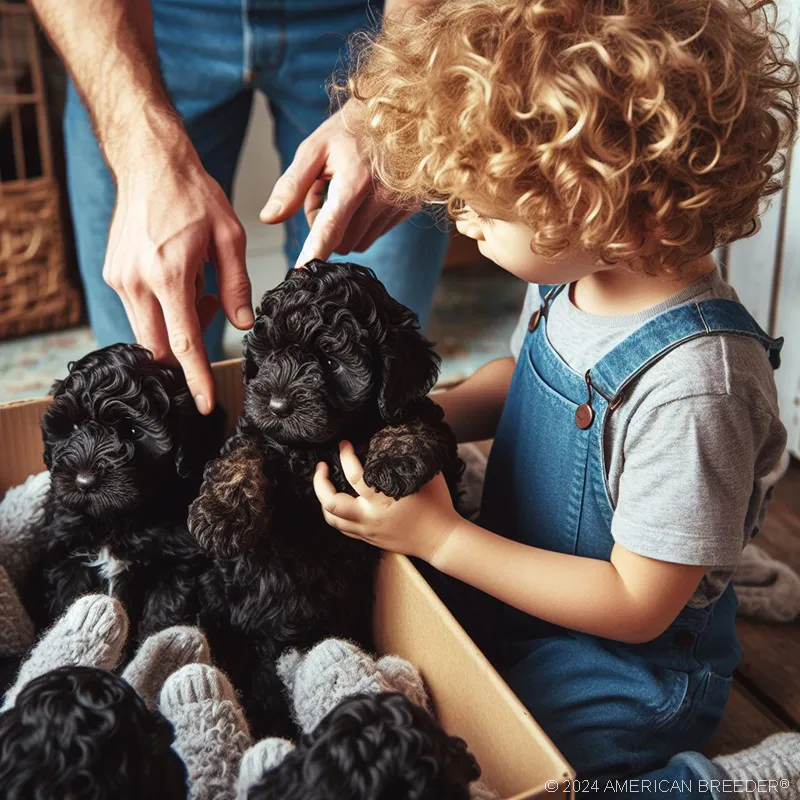 Historical Significance or Cultural Relevance
Historical Significance or Cultural Relevance
Throughout history, the Curly-Coated Retriever played a vital role in the lives of hunters and fishermen, assisting in retrieving waterfowl and game from lakes and rivers. Its water-repellent coat and strong swimming abilities made it an invaluable asset in the field.
In addition to its working abilities, the Curly's engaging and friendly personality made it a cherished family companion. The breed's versatile nature allowed it to adapt to various roles, from the hunting field to the family hearth.
Purpose or Original Use of the Curly-Coated Retriever Dog
The Curly-Coated Retriever was purposefully bred to be an exceptional retriever of waterfowl. Its primary role was to assist hunters in retrieving ducks and other waterfowl that were shot down during hunting expeditions. Its ability to work tirelessly in water, combined with its tenacity and enthusiasm, made it a prized companion for hunters.
The breed's love for water, coupled with its water-resistant coat, allowed it to excel in wet and challenging conditions. As hunting techniques evolved over the years, the Curly-Coated Retriever's popularity remained strong, earning it a place as one of the most reliable and versatile retriever breeds.
Kennel Clubs that Classify, Group, or Register the Curly-Coated Retriever
Several prominent kennel clubs recognize and classify the Curly-Coated Retriever based on its distinctive attributes and working abilities. Some of these kennel clubs include -
American Kennel Club (AKC): The Curly-Coated Retriever is classified under the Sporting Group by the AKC, which includes breeds bred for hunting and retrieving.
The Kennel Club (UK): The Curly-Coated Retriever is recognized under the Gundog Group by The Kennel Club in the United Kingdom, emphasizing its historical role as a skilled hunting companion.
Appearance
Size, Weight, Activity Level, and Physical Appearance
The Curly-Coated Retriever is a medium to large-sized dog with a well-balanced and athletic build. Males typically stand between 25 to 27 inches at the shoulder, while females are slightly smaller, ranging from 23 to 25 inches. Adult Curly-Coated Retrievers generally weigh between 60 to 95 pounds, with males being larger and heavier than females.
The breed's overall appearance exudes strength and elegance. Their lively, confident gait and alert expression showcase their intelligence and readiness for action. The Curly's robust frame and athletic build make it an agile and energetic companion for various activities.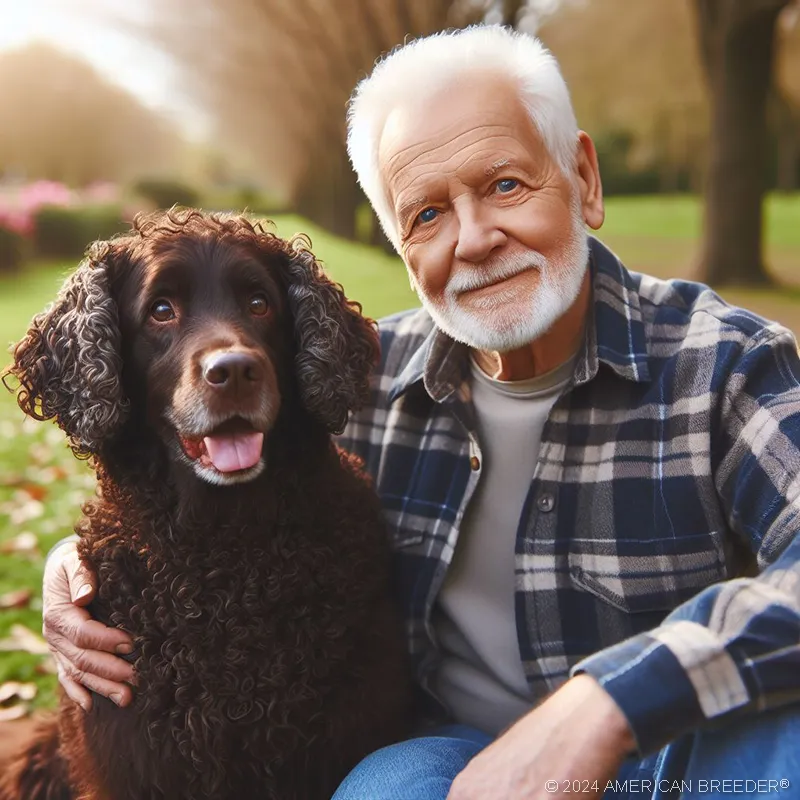 Coat Type, Color Variations, and Patterns
Coat Type, Color Variations, and Patterns
The Curly-Coated Retriever's most striking feature is its dense and tight-curled coat, which covers its entire body. The unique curls serve as natural insulation and help protect the dog from cold water during hunting expeditions. This water-resistant coat is key to the breed's success as a waterfowl retriever.
The Curly's coat comes in two solid colors: black and liver (chocolate). Both color variations are equally admired for their beauty and striking contrast against the white blaze on the chest. While rare, there are occasional instances of yellow or red-coated Curly-Coated Retrievers.
Distinctive Features or Markings
Beyond its curly coat, the Curly-Coated Retriever possesses several distinctive features that set it apart from other retriever breeds. These features include a prominent black or liver nose, oval-shaped eyes that are typically dark brown, and pendant ears that hang close to the head.
The breed's muzzle is long and straight, and its tail is carried straight or slightly curved upward. With a keen and intelligent expression, the Curly-Coated Retriever exudes a sense of alertness and enthusiasm for life.
Average Litter Size for the Curly-Coated Retriever
The average litter size for a Curly-Coated Retriever can vary, but it generally ranges from 6 to 8 puppies. As with any breed, the litter size may vary depending on the individual dog and breeding pair. Responsible breeders carefully select mating pairs to ensure the health and temperament of the offspring. Additionally, factors such as the age and health of the dam and the sire can also influence litter size.
Breeding a Curly-Coated Retriever should always be approached with great care and consideration. Responsible breeders prioritize the health and well-being of the dogs and work to improve the breed's overall quality. They also follow ethical breeding practices to avoid contributing to overpopulation and prevent potential health issues.
Temperament and Personality
Typical Temperament Traits and Behavior Tendencies
The Curly-Coated Retriever is renowned for its cheerful, outgoing, and friendly disposition. It is an affectionate and devoted breed, forming strong bonds with its family members. Curly-Coated Retrievers are known for their playful and fun-loving nature, making them great companions for families with children and other pets. Energy Levels and Activity Requirements
Energy Levels and Activity Requirements
As a working breed, the Curly-Coated Retriever has high energy levels and requires regular exercise to stay happy and healthy. Daily walks, play sessions, and outdoor activities are essential to satisfy their physical and mental needs. Engaging in retrieving games and water-based activities is particularly enjoyable for these water-loving dogs.
Compatibility with Different Lifestyles and Family Dynamics
The Curly-Coated Retriever's adaptable nature makes it a suitable companion for various lifestyles. Whether you're an active individual seeking a four-legged exercise partner or a family looking for a loyal and playful addition, the Curly has the versatility to fit in with different family dynamics.
List of Typical Behavior Issues
Aggression and Biting: Curly-Coated Retrievers are generally not aggressive by nature, but like all dogs, they require proper socialization and training from an early age to prevent any aggressive behavior.
Excessive Barking: Curly-Coated Retrievers are known for their alertness and tendency to bark when they sense something out of the ordinary. Early training can help curb excessive barking.
Digging Behavior: Some Curly-Coated Retrievers may display digging behavior, especially when bored or seeking attention. Providing sufficient mental and physical stimulation can minimize this behavior.
Separation Anxiety: This breed can form strong bonds with their owners, which may lead to separation anxiety when left alone for extended periods. Gradual training and positive reinforcement can help them cope with alone time.
Resource Guarding: Like many dogs, some Curly-Coated Retrievers may display resource guarding behavior, such as protecting their food or toys. Early training and proper management can address this issue.
Fear and Phobias: Some individuals may be more prone to fear and phobias, which can be managed through gradual exposure and positive reinforcement training.
Trainability and Intelligence
Trainability Level and Ease of Learning
The Curly-Coated Retriever is a highly trainable breed, thanks to its intelligence and eagerness to please its owners. However, they can also have an independent streak, so consistent and positive reinforcement-based training methods work best. Keeping training sessions fun, engaging, and rewarding will help maintain their interest and cooperation.
Willingness to Please Their Owner
Curly-Coated Retrievers are known for their strong desire to please their owners. This willingness to please, combined with their intelligence, makes them quick learners and eager participants in training sessions.
Intelligence and Problem-Solving Abilities
Ranked among the most intelligent dog breeds, the Curly-Coated Retriever has a keen mind and excellent problem-solving abilities. They can quickly learn complex commands and excel in various dog sports and activities.
Recommended Training Approaches and Techniques
Positive reinforcement training is highly effective with Curly-Coated Retrievers. Using rewards such as treats, praise, and play motivates them to learn and obey commands willingly. Harsh training methods or punishment should be avoided, as they can damage the strong bond between the dog and its owner.
Training or Skills Best Suited for the Curly-Coated Retriever
Curly-Coated Retrievers shine in activities that engage their natural retrieving instincts and intelligence. Their exceptional retrieving skills make them well-suited for dog sports such as agility, obedience, rally, and dock diving. Moreover, they excel in field trials and hunting competitions, showcasing their versatility as a working dog.
Practical Considerations
Size of Sleeping Quarters Depending on Size
The Curly-Coated Retriever is a medium to large-sized dog that requires ample space to move and stretch comfortably. Providing a cozy dog bed or crate that is appropriate for their size will offer a comfortable and secure sleeping quarters.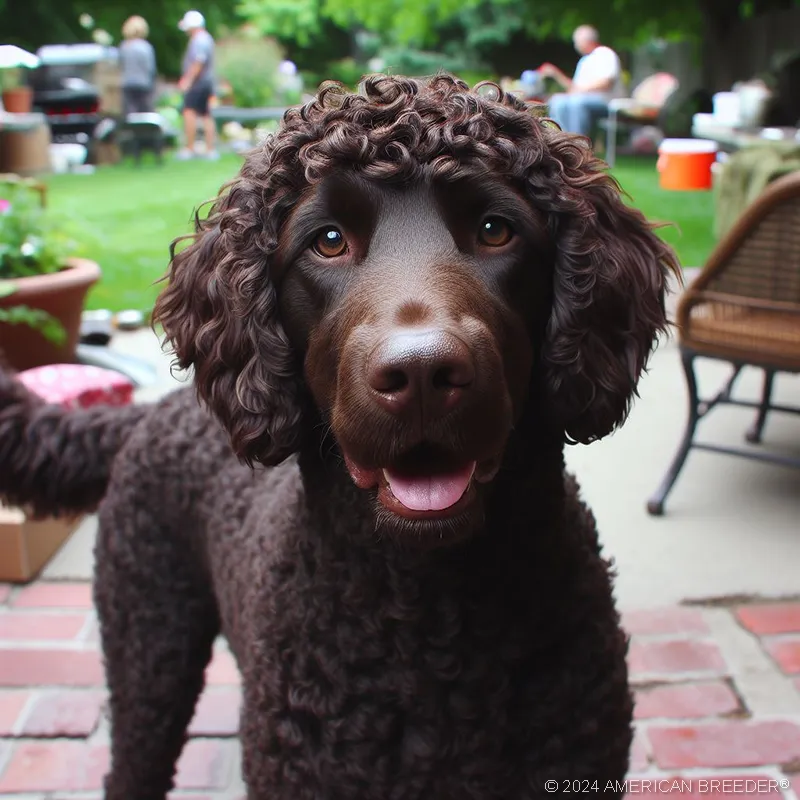 Typical Annual Veterinary Cost
Typical Annual Veterinary Cost
Like all dogs, the Curly-Coated Retriever requires routine veterinary care to maintain good health. Annual check-ups, vaccinations, and preventive treatments for parasites are essential for their well-being. The average annual veterinary cost can vary based on the dog's age and overall health, but owners should budget for regular veterinary expenses.
Type of Grooming and Annual Cost
The Curly-Coated Retriever's unique curly coat requires regular grooming to keep it in top condition. Brushing the coat two to three times a week is necessary to prevent matting and remove debris. Additionally, professional grooming every few months can help maintain the coat's appearance and texture.
Daily Exercise Needs and Requirements
Curly-Coated Retrievers are energetic dogs that require regular exercise to keep them physically and mentally stimulated. Daily walks, playtime, and opportunities for retrieving games will help fulfill their exercise needs and prevent boredom-related behaviors.
Level of Playfulness
The Curly-Coated Retriever is a playful and exuberant breed that enjoys interactive games and activities. Their playful nature makes them wonderful companions for families and individuals who can provide them with plenty of playtime and enrichment.
Level of Intelligence
Ranked among the most intelligent dog breeds, the Curly-Coated Retriever is highly intelligent and quick to learn. Their intelligence makes training and engaging in complex activities a rewarding experience for both the dog and the owner.
Affection Level and Desired Attention
Curly-Coated Retrievers are affectionate and loving dogs that enjoy being close to their family members. They thrive on human interaction and prefer to be included in family activities. Offering them love, attention, and positive reinforcement strengthens their bond with their owners.
Friendliness Toward Strangers
While Curly-Coated Retrievers are generally friendly and sociable, they may initially be reserved or aloof around strangers. Proper socialization from an early age can help them become more comfortable and confident in different social situations.
Grooming Needs and Frequency
The Curly-Coated Retriever's unique coat requires regular grooming to keep it clean and healthy. Brushing the curly coat two to three times a week will help prevent tangles and mats, ensuring the coat maintains its water-resistant properties. Regular grooming also allows owners to check for any skin issues or abnormalities.
Brushing: Use a slicker brush or a comb with rotating teeth to gently remove tangles and debris from the coat. Regular brushing will help distribute natural oils, keeping the coat healthy and shiny.
Bathing: Curly-Coated Retrievers generally do not require frequent bathing unless they have rolled in something particularly dirty or smelly. Use a mild dog shampoo and thoroughly rinse the coat to remove any residue.
Nail Trimming: Regular nail trimming is essential to prevent overgrowth, which can cause discomfort and affect the dog's gait. Use a dog-specific nail clipper and trim the nails carefully, avoiding cutting too close to the quick.
Ear Cleaning: Check the ears regularly for dirt, wax buildup, or signs of infection. Use a dog ear cleaning solution and a soft cloth to gently clean the ears, being cautious not to insert anything deep into the ear canal.
Feeding Requirements and Dietary Considerations
The Curly-Coated Retriever should be fed a balanced and nutritious diet suitable for their age, size, and activity level. High-quality commercial dog food that meets the breed's nutritional needs is recommended. Consult with a veterinarian to determine the appropriate portion size and feeding schedule based on the individual dog's requirements.
Portion Sizes: The amount of food needed depends on the dog's age, weight, and activity level. Overfeeding should be avoided to prevent obesity, which can lead to various health issues.
Feeding Schedule: Establish a regular feeding schedule with two meals a day for adult dogs. Puppies may require more frequent meals to support their growth and development.
Recommended Dog Food Brands/Types: Look for reputable dog food brands that offer complete and balanced nutrition. Consider options formulated for medium to large-sized breeds and designed for the dog's age and activity level.
Treats and Dietary Restrictions: Use treats in moderation during training and as rewards. Avoid feeding table scraps or foods that are toxic to dogs, such as chocolate, grapes, onions, and garlic.
Health and Care
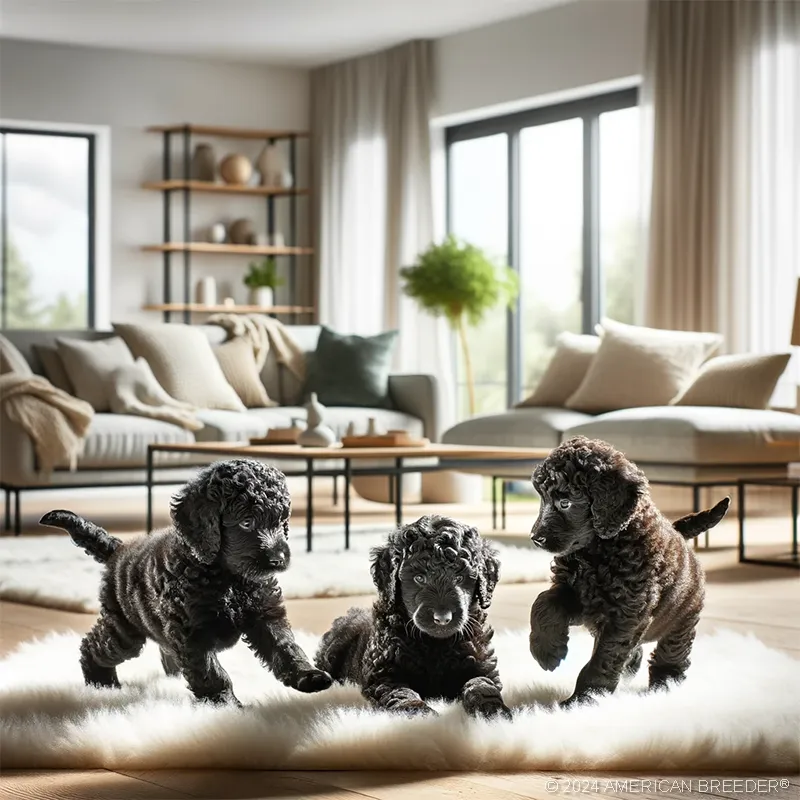 Common Health Issues or Predispositions of the Curly-Coated Retriever
Common Health Issues or Predispositions of the Curly-Coated Retriever
While the Curly-Coated Retriever is generally a healthy breed, like all dogs, it may be prone to certain health issues. Common health concerns include hip dysplasia, progressive retinal atrophy (PRA), and certain heart conditions. Responsible breeders conduct health screenings and genetic testing to reduce the risk of hereditary health problems in their breeding lines.
Allergies and Specific Dietary Considerations
Some Curly-Coated Retrievers may develop allergies to certain foods or environmental triggers. Pay attention to any signs of food intolerance or sensitivity, such as skin irritations or digestive issues, and work with a veterinarian to identify potential allergens and adjust the diet accordingly.
Lifespan and Longevity Expectations
The Curly-Coated Retriever has a relatively long lifespan, typically ranging from 10 to 12 years or more with proper care and a healthy lifestyle. Regular veterinary check-ups, a balanced diet, regular exercise, and preventive healthcare measures can contribute to their longevity.
Grooming Requirements Based on Coat Type and Size
The Curly-Coated Retriever's curly coat requires regular grooming to keep it clean and healthy. Brushing the coat two to three times a week will help prevent tangles and mats, ensuring the coat maintains its water-resistant properties. Regular grooming also allows owners to check for any skin issues or abnormalities.
Exercise Needs and Recommendations for Physical and Mental Stimulation
Curly-Coated Retrievers are active and energetic dogs that require regular exercise and mental stimulation. Engaging in daily walks, play sessions, and retrieving games will help fulfill their physical and mental needs. Dog sports and activities, such as agility, obedience, and tracking, can provide additional mental stimulation and strengthen the bond between the dog and its owner.
Nutrition and Feeding Guidelines
A balanced and nutritious diet is crucial for the Curly-Coated Retriever's overall health and well-being. Providing high-quality commercial dog food that meets the breed's nutritional requirements, along with appropriate portion control, will help maintain a healthy weight and support their active lifestyle.
Vaccination Schedule and Preventive Care
Keeping the Curly-Coated Retriever up-to-date with vaccinations is vital to protect them from common infectious diseases. Core vaccines, such as rabies, distemper, and parvovirus, are essential, along with non-core vaccines based on the dog's lifestyle and risk factors. Preventive care, such as regular parasite control and dental care, is also crucial to maintaining their health.
Core Vaccines: These include vaccinations against rabies, distemper, parvovirus, and adenovirus. They are considered essential for all dogs, regardless of breed.
Non-Core Vaccines: Non-core vaccines may include vaccinations against diseases such as kennel cough or leptospirosis. Consult with a veterinarian to determine which non-core vaccines are appropriate for your dog's lifestyle.
Flea and Tick Prevention: Regular flea and tick prevention are essential to protect the Curly-Coated Retriever from parasites that can transmit diseases.
Heartworm Prevention: Heartworm prevention is crucial to safeguarding the dog from heartworm disease, which is transmitted by mosquitoes.
Regular Health Check-ups and Vet Visits
Regular health check-ups are vital to monitor the Curly-Coated Retriever's overall health and detect any potential issues early. Annual veterinary check-ups allow for preventive care, dental exams, and monitoring for any changes in the dog's health.
Signs of Potential Health Problems and When to Seek Veterinary Attention
As a responsible owner, it is essential to be vigilant for any signs of potential health problems in your Curly-Coated Retriever. Some common signs of health issues may include changes in appetite, weight loss or gain, lethargy, excessive thirst, changes in bowel movements, limping, and skin irritations. If you notice any of these symptoms or any other unusual behavior, it is crucial to seek veterinary attention promptly.
Socialization and Compatibility
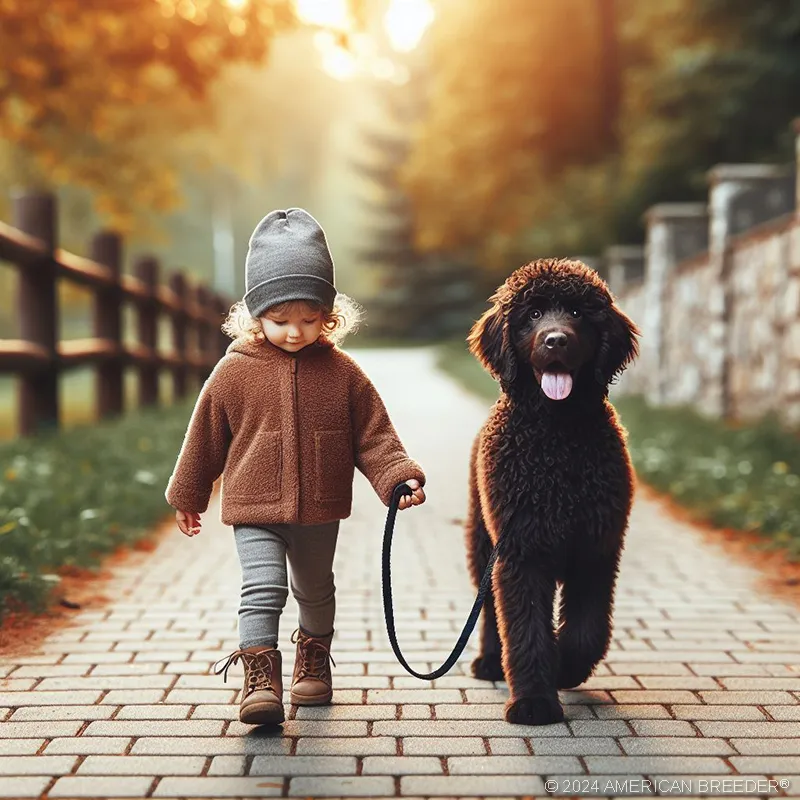 Interaction with Children, Other Pets, and Strangers
Interaction with Children, Other Pets, and Strangers
Curly-Coated Retrievers are generally friendly and sociable with children, other pets, and strangers when properly socialized. Early and positive exposure to different people and animals helps shape their social behavior positively.
Socialization Needs and Tips for Proper Socialization
Socialization is a critical aspect of raising a well-adjusted and confident Curly-Coated Retriever. Introduce the puppy to various environments, people of all ages, other dogs, and different situations to help them become comfortable in different settings.
Precautions or Considerations for Multi-Dog Households
When introducing a Curly-Coated Retriever to a multi-dog household, it's essential to do so gradually and under supervision. Each dog's personality and temperament should be considered to ensure compatibility and a harmonious living environment.
Level of Ease When It Comes to Training Curly-Coated Retrievers
Curly-Coated Retrievers generally respond well to training, thanks to their intelligence and eagerness to please. However, as with any breed, consistent and positive reinforcement-based training is essential to achieve the best results.
Playtime and Exercise with Other Dogs or Pets
Curly-Coated Retrievers often enjoy playing and exercising with other dogs and pets. Engaging in interactive play and activities with fellow furry friends can strengthen social bonds and provide additional mental stimulation.
Dog-Friendly Activities and Outings
Curly-Coated Retrievers love being active and participating in outdoor activities. Take them on hikes, visits to the beach, or other dog-friendly outings to keep them engaged and happy.
Living Arrangements and Environment
Suitability for Different Living Arrangements
The Curly-Coated Retriever is adaptable to various living arrangements, including houses with yards and apartments. However, due to their active nature, they do best in homes with ample space for exercise and play.
Space Requirements and Exercise Options
Owners should provide enough space for the Curly-Coated Retriever to move and play comfortably. A securely fenced yard is ideal for off-leash play and exercise. Regular walks, trips to the dog park, and outdoor playtime are also essential to meet their exercise needs.
Climate Considerations and Adaptability
Curly-Coated Retrievers can adapt to various climates, but they do best in moderate climates. In extreme heat or cold, take precautions to ensure their safety and comfort during outdoor activities.
Recommended Yard Size for Curly-Coated Retrievers
A medium to large-sized yard is preferable for a Curly-Coated Retriever to have space for play and exercise. Secure fencing is essential, as they may be prone to wander if not properly supervised.
Ideal Living Conditions and Environment
The ideal living conditions for a Curly-Coated Retriever include a loving home with an active and engaged owner. They thrive in environments where they receive regular exercise, mental stimulation, and social interaction with their family.
Training and Obedience
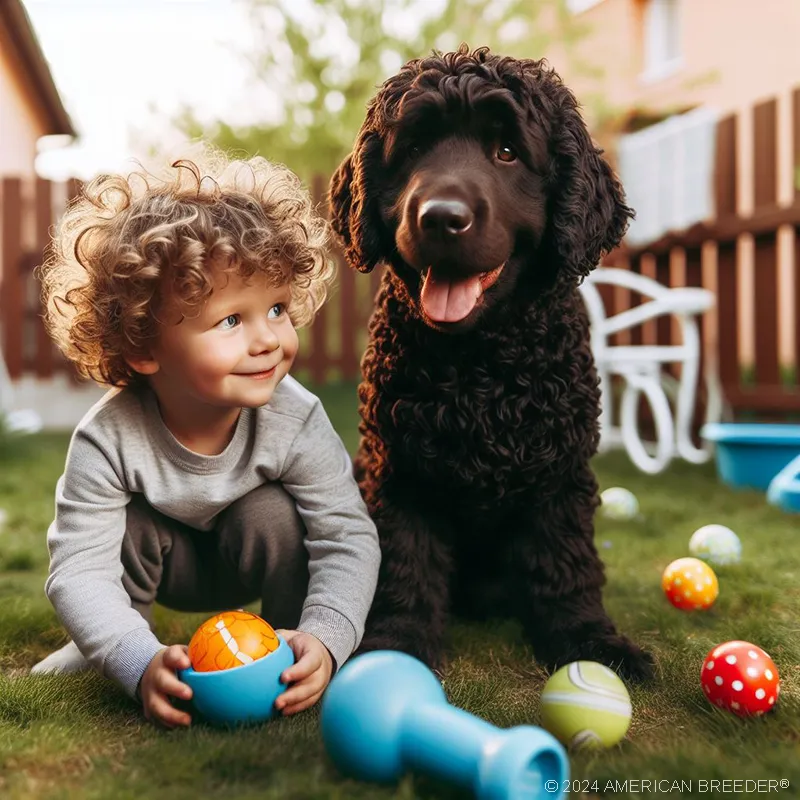 Basic Obedience Training and Commands
Basic Obedience Training and Commands
Basic obedience training is crucial for a well-mannered and well-behaved Curly-Coated Retriever. Teach essential commands such as sit, stay, come, and heel using positive reinforcement techniques.
Advanced Training or Specialized Activities Suited for Curly-Coated Retrievers
Curly-Coated Retrievers excel in advanced training and specialized activities due to their intelligence and versatility. Training for activities such as agility, obedience trials, and fieldwork can be both mentally stimulating and physically engaging.
Behavioral Challenges or Specific Training Considerations
Address any potential behavioral challenges through early and consistent training. Use positive reinforcement to redirect undesirable behaviors and promote positive behavior.
House Training and Potty Training Tips
House training should begin as soon as the puppy arrives home. Establish a regular feeding and potty schedule to reinforce positive habits. Use positive reinforcement and crate training to encourage good potty behavior.
Leash Training and Walking Etiquette
Leash training is essential to ensure a safe and enjoyable walking experience with a Curly-Coated Retriever. Teach loose-leash walking and reinforce good walking etiquette to prevent pulling and lunging.
Exercise and Activity
Daily Exercise Needs and Recommendations
Curly-Coated Retrievers have high exercise needs due to their active nature. Engage in at least 60 minutes of exercise per day, which can include walks, playtime, and retrieving games.
Mental Stimulation Activities and Games
In addition to physical exercise, Curly-Coated Retrievers need mental stimulation to keep their minds sharp and prevent boredom. Engage them in interactive games, puzzle toys, and training sessions to challenge their intelligence.
Exercise Routines and Activity Ideas
Develop a varied exercise routine that includes different activities to keep your Curly-Coated Retriever engaged. Mixing up walks, playtime, and training sessions will help keep them mentally and physically stimulated.
Energy Outlets for High-Energy Breeds
Curly-Coated Retrievers are high-energy dogs that require outlets for their energy. Engaging them in activities such as agility, dock diving, or retrieving games can help channel their energy in positive ways.
Financial Planning
Typical Price Range for Purchasing a Curly-Coated Retriever from Reputable Breeders
The price of a Curly-Coated Retriever from a reputable breeder can range from $1,500 to $3,000 or more, depending on the breeder's location and the dog's pedigree.
Initial Costs
Initial costs include the purchase price, vaccinations, spaying/neutering, and microchipping. Additional expenses may include a crate, bed, toys, and other essential supplies.
Ongoing Expenses
Ongoing expenses for a Curly-Coated Retriever include food, grooming, veterinary care, training classes, and supplies. Budgeting for these recurring costs is essential for responsible ownership.
Considerations for Pet Insurance or Budgeting for Unexpected Medical Costs
Pet insurance can help offset the cost of unexpected medical expenses. Alternatively, setting aside a budget for emergency veterinary care can provide financial security in case of unforeseen health issues.
Options for Pet Care During Vacations or Travel
Plan ahead for pet care during vacations or travel. Options may include boarding kennels, pet sitters, or trusted friends or family members who can care for your Curly-Coated Retriever in your absence.
Responsible Ownership and Ethical Considerations
Adopting from Shelters or Rescues
Consider adopting a Curly-Coated Retriever from a shelter or rescue organization. By adopting, you give a loving home to a dog in need and contribute to reducing pet overpopulation.
Researching and Choosing Reputable Breeders
If purchasing from a breeder, research and choose a reputable breeder who prioritizes the health and well-being of their dogs. Look for breeders who conduct health screenings, provide a clean and nurturing environment for their dogs, and are knowledgeable about the breed's characteristics and care.
Avoiding Puppy Mills and Supporting Ethical Breeding Practices
Avoid purchasing a Curly-Coated Retriever from puppy mills, which prioritize profit over the welfare of their dogs. Puppy mills often subject dogs to inhumane conditions and neglect proper care and socialization. Supporting ethical breeding practices helps ensure that dogs are raised in a loving and responsible manner.
Spaying/Neutering Considerations and Responsible Breeding Decisions
Responsible owners should consider spaying/neutering their Curly-Coated Retriever unless they plan to responsibly breed. Spaying/neutering not only helps prevent unwanted litters but also offers health benefits for the dog.
Commitment and Time Dedication Required for Responsible Dog Ownership
Owning a Curly-Coated Retriever requires a significant commitment of time and energy. They are social dogs that thrive on companionship and interaction with their family. Be prepared to devote time to training, exercise, grooming, and providing affectionate attention to your furry companion.
Legal Responsibilities and Regulations
Licensing Requirements and Local Regulations for Dog Ownership
Familiarize yourself with local licensing requirements and regulations for dog ownership. Many areas require dogs to be licensed, and there may be specific leash laws and other regulations to follow.
Understanding Leash Laws, Vaccination Requirements, and Other Legal Obligations
Adhere to leash laws and vaccination requirements to ensure the safety of your Curly-Coated Retriever and others in the community. Failure to comply with legal obligations may result in fines or other consequences.
Overall Summary
Concise and Cohesive Summary of Key Details in Bullet-Point Format
Curly-Coated Retrievers are a versatile and intelligent breed known for their distinctive curly coat and friendly demeanor. They have a rich history as skilled retrievers used in hunting and water activities.
Curly-Coated Retrievers are suitable for families and active individuals who can provide them with ample exercise and mental stimulation.
Regular grooming and exercise are necessary to maintain their coat and prevent behavioral issues. Responsible ownership involves training, socialization, and ensuring their health and well-being.
Highlight Interesting and Fun Facts about Curly-Coated Retrievers
Curly-Coated Retrievers are one of the oldest retriever breeds, dating back to the late 18th century.
They are often called "curlies" by their affectionate nickname.
Despite their curly coats, they are relatively low shedders compared to other breeds.
Curly-Coated Retrievers are natural-born swimmers, making them exceptional water retrievers.
Capture the Breed's Unique Characteristics and Appeal
Curly-Coated Retrievers are captivating dogs with their unique curly coat, friendly disposition, and playful nature. Their love for water and retrieving is a testament to their original purpose as skilled hunting companions. Their intelligence and versatility make them excellent competitors in various dog sports and activities.
Create Excitement and Enthusiasm for Potential Dog Owners
For potential dog owners seeking a loyal and affectionate companion with a love for outdoor adventures, the Curly-Coated Retriever is an excellent choice. Their vibrant personality and distinctive appearance are sure to win the hearts of those looking for a devoted and energetic canine companion.
Conclusion
Summary of Key Information and Considerations for Curly-Coated Retrievers
Throughout this guide, we have explored the wonders of the Curly-Coated Retriever breed, from their historical significance to their distinct physical attributes and temperament. We've covered essential topics such as grooming, training, health care, and responsible ownership.
Encouragement to Continue Learning and Seeking Expert Guidance
As a potential or current owner of a Curly-Coated Retriever, your journey with this incredible breed is just beginning. Continue to learn about their needs and behaviors, seek expert guidance when needed, and engage in activities that promote a strong bond and enrich both your lives.
Emphasis on Responsible Ownership, Commitment, and Providing a Loving, Suitable Home for a Dog
Owning a Curly-Coated Retriever is a significant responsibility, but it is also a rewarding experience filled with love and companionship. Always prioritize their health, well-being, and happiness, and remember that a well-cared-for Curly-Coated Retriever will be a devoted and loyal member of your family for many years to come.
In conclusion, the Curly-Coated Retriever is a remarkable breed with a rich history, a charming personality, and an inherent love for water and retrieving. Their curly coat sets them apart from other retrievers, and their intelligence and versatility make them exceptional companions and competitors in various dog sports.
Responsible ownership, regular exercise, and proper grooming are key to ensuring their well-being and happiness. Whether you're seeking an active partner for outdoor adventures or a loving family companion, the Curly-Coated Retriever is sure to bring joy and companionship to your life. Embrace the journey of being a proud owner of this extraordinary breed, and may the bond between you and your Curly-Coated Retriever grow stronger with each passing day.
Curly-Coated Retriever Dog Quick Reference Guide
Breed Background: Origin: England | Breed Purpose: Waterfowl Retrieval | AKC Class: Sporting Group | Year Recognized by AKC: 1924
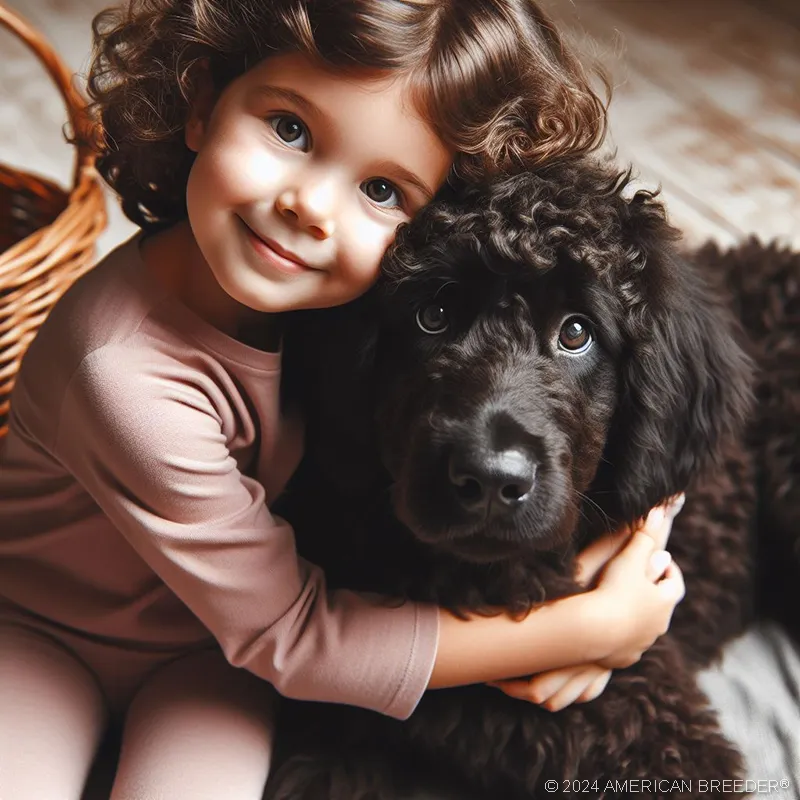 Appearance: Size: Medium to Large | Weight: 60-95 pounds | Coat Type: Curly, Water-resistant | Colors & Patterns: Black or Liver | Distinctive Features: Tight Curls, Alert Expression
Appearance: Size: Medium to Large | Weight: 60-95 pounds | Coat Type: Curly, Water-resistant | Colors & Patterns: Black or Liver | Distinctive Features: Tight Curls, Alert Expression
Temperament: Energy Level: 4 | Friendliness to Pets: 4 | Friendliness to Strangers: 3 | Trainability: 4 | Playfulness: 4 | Frequent Barker: 2 | Chase Instincts: 4 | Sense of Smell: 5 | Drive to Hunt: 5
Health & Care: Health Issues: Generally Healthy, Hip Dysplasia, Eye Conditions | Lifespan: 10-14 years | Grooming Difficulty: Moderate | Exercise Needs: High
Socialization: Interaction with Children: Good, Playful | Interaction with Pets: Moderate, Early Socialization Helps | Interaction with Strangers: Reserved | Ease of Training: Moderate
Suitable Living Arrangements: Apartment: Not Ideal | House: Yes | Rural Area: Preferable | Yard Size Requirements: Medium to Large Yard
Training & Obedience: Trainability: 3 | Intelligence: 4 | Obedience: 3 | Problem-Solving: 3 | Easily Stimulated: 4 | Focus Level: 3 | Easily Distracted: 3
Financial Planning: Typical Price Range: $1000 - $2500 | Initial Expenses: Vaccinations, Microchipping, Training | Ongoing Annual Expenses: Food, Grooming, Veterinary Care
Breeding: Reproductive Maturity: 18-24 months | Litter Frequency: 1-2 litters per year | Litter Size: 6-8 puppies | Stud Cost: $800 - $1500 | Breeding Challenges: Caring for Large Litters, Finding Suitable Mates
Did You Enjoy this Article? Share it and Help Us Spread the Word!
If you found this article helpful, we'd appreciate it if you could share it with your friends or link to it from your website, blog, or group! You can also use the convenient social share tabs on the left side of the screen to instantly share this page to your social media feed. For more ways to support and promote the American Breeder Community, visit our Share & Promote Together page for social media posts and memes you can copy and share. Your support means the world to us!
Disclaimer: The information provided in this article is for general informational purposes only and does not constitute legal, medical, financial, or professional advice. While we strive for accuracy, we make no representations or warranties regarding the completeness, accuracy, reliability, or suitability of the information. Please consult with a professional before making decisions based on the content provided. American Breeder Inc. assumes no responsibility for any errors or omissions or for the results obtained from the use of this information.
